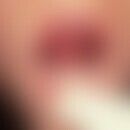Synonym(s)
DefinitionThis section has been translated automatically.
Topical, lipophilic, imidazole antifungal with a broad antifungal spectrum and weak antibacterial activity.
Pharmacodynamics (Effect)This section has been translated automatically.
Azoles inhibit the microsomal cytochrome P450-dependent lanosterol 14-alpha-demethylation, a step in the synthesis of ergosterol. this leads to disturbances in membrane permeability and to inhibition of fungal growth.
Clotrimazole is acid labile. At a ph < 5 it is hydrolytically split and thus ineffective.
The approximately pH-neutral urea can easily be combined with Clotrimazol (example: 40% urea paste with 1% Clotrimazol - NRF 11.57. for the conservative treatment of onychomycosis)
Clotrimazole can be combined with the alkaline zinc oxide in the whole spectrum of hydrophilic and lipophilic creams without any difficulties (e.g. in base cream DAC).
The clotriamzole effect is classified as fungistatic. In case of local application it is not systemically resorbed. Resistances are rare. Furthermore Clotrimazol is effective against gram-positive bacteria.
You might also be interested in
IndicationThis section has been translated automatically.
Pregnancy/nursing periodThis section has been translated automatically.
Clotrimazole local can be used after the 1st trimester in pregnancy. Clotrimazole (besides Nystatin) can also be used for the frequent vaginal mycoses in pregnancy.
Dosage and method of useThis section has been translated automatically.
- Solution/spray/paste/cream/powder: Apply thinly 2-3 times/day for 2-4 weeks to the affected skin areas.
- Vaginal ovula 2 times/day 1 g (partner treatment!).
Standard concentrationThis section has been translated automatically.
Undesirable effectsThis section has been translated automatically.
- Allergic reactions to Clotrimazole are extremely rare. In a larger series of 2,512 people tested, a positive reaction was detected 26 times (1%). The DKG has tested Clotrimazole 5% in Vaseline so far. This application form is no longer available as a test substance in Germany. Therefore, a 1% concentration of Clotrimazole in Vaseline is now (as of 2016) recommended.
- Pruritus
- for vaginal application: abdominal spasms, feeling of fullness, dyspareunia.
InteractionsThis section has been translated automatically.
With simultaneous use of Natamycin or Nystatin there is a mutual reduction in effectiveness. The pH dependence (hydrolysis at pH <5.5) results in an incompatibility with acids (e.g. salicylic acid , which produces a pH of 2-3 in water-containing vehicle systems) and acid salts! Clotrimazole is compatible with erythromycin in formulations. Furthermore, combinations with different types of alcohol are also possible. Glucocorticoids are also possible (see below).
ContraindicationThis section has been translated automatically.
Recipe(s)This section has been translated automatically.
- 2% Clotrimazole ointment
- 2% Clotrimazole tincture
- Clotrimazole solution: R055
- Clotrimazole zinc ointment: R058;
Less suitable as a base is the hydrophilic ointment DAB. On the other hand, the base cream DAC and the non-ionic hydrophilic cream are very suitable and can be stored at 25°C for 3 months.
Combination with erythromycin: The following formula is recommended:
- erythromycin 0,5
- clotrimazole 2,0
- NaHCo3 - solution 4.2% q.sat. pH 8-8.5
- Eucerin c.aqua ad 100.0.
Combinations with glucocorticoids:
The customary corticoids"prednicarbate, hydrocortisone, triamcinolone acetonide, mometasone furoate, betamethasone dipropionate and clobetasol propionate are themselves not pH active and are Ph ranges between 3.5-5.5 stable. They can therefore be combined with clotrimazole. Clotrimazole can also be added to standardized formulations. The following sample formulations are possible (according to Reimann):
- Rp:
- clotrimazole 0.5
- Hydrophilic prednicarbate cream 0,15% (NRF 11.144.) ad 50,0
- ----------------------------------------------------------------------------------------
- Rp:
- clotrimazole 0,5
- Trimacinolone acetonide emulsion 0,1% (NRF 11.47.) ad 50,0
- --------------------------------------------------------------------------------------------
Combinations with salicylic acid:
Aqueous salicylic acid solutions react strongly acidic (pH 2.5). These combinations are therefore considered incompatible. However, a hydrophilic salicylic acid cream (up to 5%) with Clotrimazole 1% can be kept in the refrigerator for 4 weeks.
- Rp (n. H Reimann):
- clotrimazole 0,5
- prednicarbate 0,125
- salicylic acid 1,0
- Base cream ad 50,0
- ----------------------------------------------------------------------------------------------
PreparationsThis section has been translated automatically.
Note(s)This section has been translated automatically.
The optimum stability of Clotrimazole is pH 7-8; Clotrimazole is acid labile and is hydrolyzed at pH values < 5. It remains stable at higher pH values. It is insoluble in water and glycerol, reasonably soluble in ethanol and isopropyl alcohol (9.5 in 100); furthermore, it is soluble in therapeutic concentrations in fatty oils but not in paraffinic dermatological ingredients.
LiteratureThis section has been translated automatically.
- Crowley PD et al (2014) Clotrimazole as a pharmaceutical: past, present and future. J Appl Microbiol 117:611-617
- Geier J et al (2016) News on the epicutaneous test series of the German Contact Allergy Group. Dermatology at work and in the environment 64: 70-75
- Grunewald S et al (2017) Dermatological topical and systemic therapy during pregnancy. Dermatologist 68:127-135.
- Nenoff P (2011) State of the Art Mycology. Compendium Dermatology 7:17-19
- Reimann H (2015) Clotrimazole in active ingredient combinations. dermatologist 66: 795-796
- Wolf G (2010) Dose inaccuracies due to sedimenting active substances. dermatologist 61: 922-923




